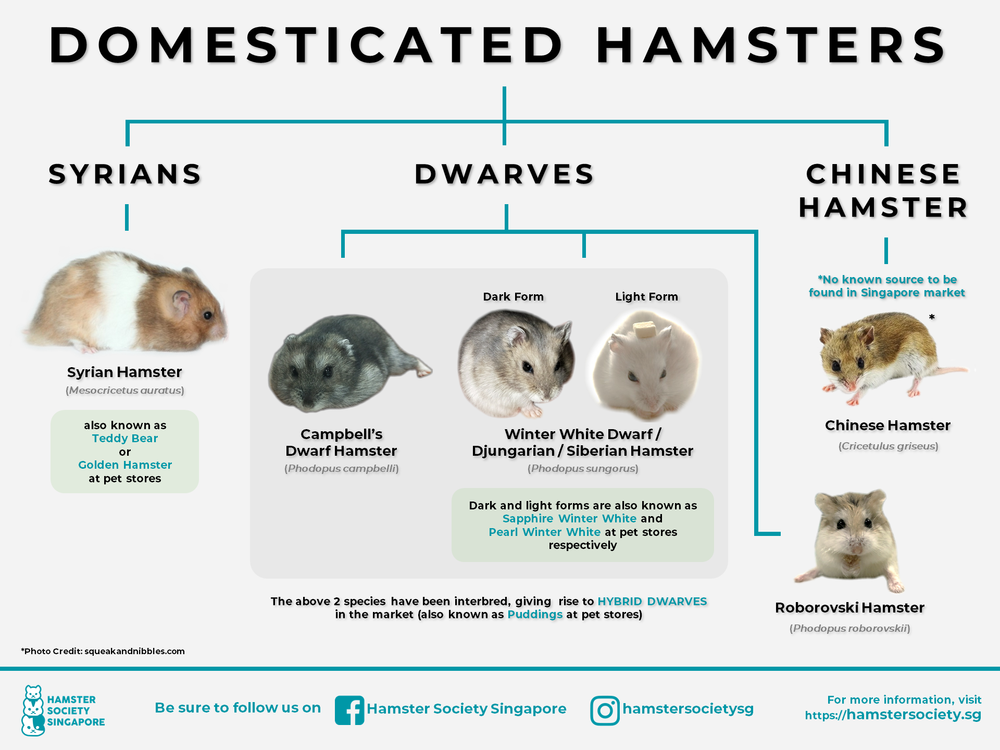Before You Buy
Commitment
When you're adopting a hamster, keep in mind that they're not just toys for a kid to play with or an easy pet you just need to feed and water. They need about an hour outside of their cages every day and their cages need to be cleaned once a month. They aren't particularly kid friendly, though some species are better than others. They live for 1.5-3 years and often need (sometimes costly) medical attention as they age. If you're not willing to commit to everything necessary to keep them happy and healthy, I suggest you look into another pet that fits your lifestyle.

Species
Consider what kind of pet you are looking for. The five most common hamster species (not breeds!) are Syrians, Chinese, Winter White, Campbell's, and Roborovskis. Each has their own unique characteristics and charm.
- Syrians
- Chinese
- Winter White Dwarfs*
- Campbell's Dwarfs*
- Roborovskis
- Source: Jay Gershman
Syrians are the largest and slowest species of hamster. They have many varieties of colors and coats and are often called things like "Teddy Bear" and "Golden" hamsters at pet stores. Syrians are territorial and should be housed alone to avoid conflicts. They are generally friendly and easy to handle, and what I'd recommend to new hamster owners.
Chinese hamsters are a bit smaller than Syrians. They look more rat-like and have a longer tail than other hamster species. It is not advised to own them in pairs. Chinese hamsters also tend to be very friendly, though can be a bit more difficult to handle than Syrians.
Winter Whites are smaller than Chinese hamsters. They are round, have white bellies and greyish brown fur that can turn white in the winter. They can be owned in groups if proper precautions are taken. They are trypically friendly and fairly easy to handle.
Campbell's are a bit smaller than Winter Whites and are generally very similar to them.
Robos are the smallest and fastest species of hamster. They typically have brown backs and white bellies. Robos are the best species to keep in same sex groups, though will also thrive alone. However, robos are the most difficult species to handle. They are very agile and aren't always interested in being handled. I recommend getting a playpen to keep them contained while playing.
*Hybrids
It should be noted that nearly every Winter White or Campbell's Dwarf sold in pet stores is a hybrid of the two species. Hybrids tend to have health and behavioral issues and can be tricky to care for. If you are interested in adopting either of these species, I'd encourage you to do some research on the challenges that come with hybrids first.
Species Overview
| Species | Size | Solitary | Handleability |
|---|---|---|---|
| Syrians | 5 - 7 in | solitary | very easy |
| Chinese | 3.2 - 5 in | solitary | easy |
| Winter White Dwarfs | 2.7 - 3.5 in | can live in groups | medium |
| Campbell's Dwarfs | 2 - 4 in | can live in groups | medium |
| Roborovskis | 1.7 - 2 in | can live in groups | difficult |
| Source: https://903pets.com/hamster-breed-size-chart-how-big-do-hamsters-get/ | |||
Adopt or Shop?
It's no secret that pet stores don't source their pets from the most ethical places. I'd recommend reading up on the issue. If you want to avoid supporting unethical breeders, you can look into private, specialized breeders. You may also be able to find a hamster to adopt that's being rehomed.